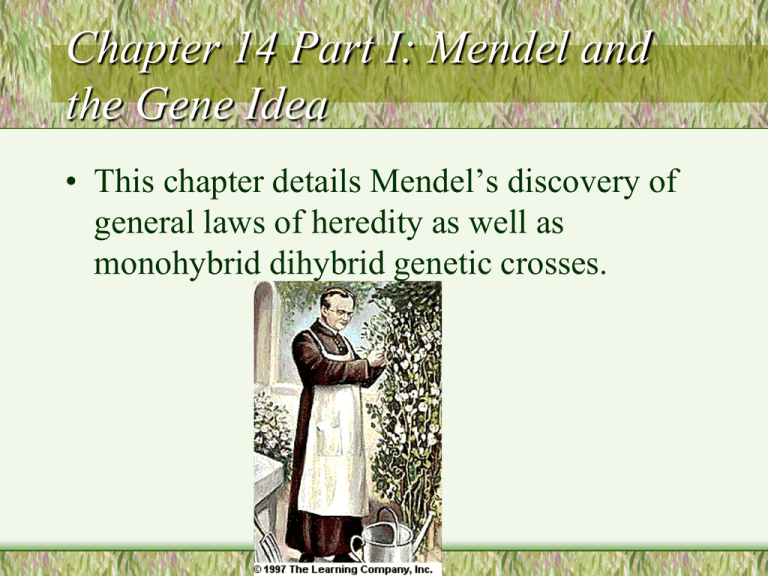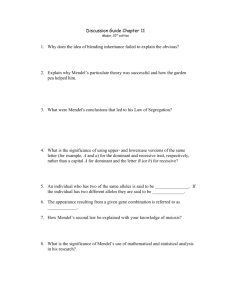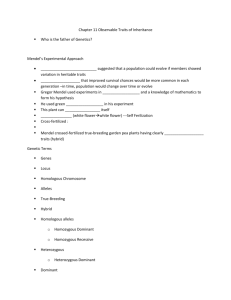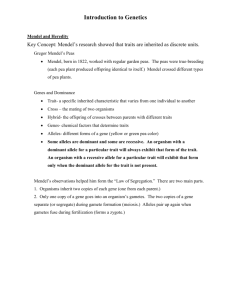Chapter 11: Mendelian Patterns of Inheritance
advertisement

Chapter 14 Part I: Mendel and the Gene Idea • This chapter details Mendel’s discovery of general laws of heredity as well as monohybrid dihybrid genetic crosses. A. Gregor Mendel 1 Austrian Monk 2 Formulated two laws of inheritance in 1860s. 3 Previously studied math and science at University of Vienna. B. Blending Concepts of Inheritance 1 Theory stated that offspring would possess traits intermediate between those of different parents. 2 Red and White flowers make Pink flowers. 3 Darwin wanted to develop a theory of evolution based on Mendel’s heredity principles. C. Mendel’s Experimental Procedure 1 Mendel did a statistical study 2 Prepared experiments carefully A. Garden Pea B . 22 true-breeding varieties C . Simple traits were studied 3 Mendel traced inheritance of individual traits. 4 Principles of probability used for interpretation. 11.2 Monohybrid Inheritance A . Cross-pollination Monohybrid Crosses 1 A hybrid is result of 2 true-breeding parents 2 A monohybrid cross is between two true-breeding parents for two distinct forms of a trait. 3 Mendel tracked 2 generations A . P Generation B . F1 Generation C . F2 Generation B. Mendel’s Results 1 Contrary results to predictions 2 F1 resembled one parent 3 1/4 of F2 resembled one parent; 3/4 resembled other parent like F1 generation. 4 3:1 ratio results A. Dominant/recessive shown in F2. B . Factors separated when gametes were formed. C . Random fusion upon fertilization. B. Mendel’s Results Continued 5 Mendel’s First Law of Inheritance: Law of Segregation A. Each organism contains 2 factors for each trait; factors segregate in formation of gametes; each gamete contains one factor for each trait. B . Factors passed from generation to generation C. As Viewed by Modern Genetics 1 Traits controlled by two alleles, alternate forms of trait found at the same gene locus. 2 Gene locus is a specific location on a gene 3 Homozygous is two identical alleles for a trait. A. Homozygous dominant - 2 dominant alleles B . Homozygous recessive - 2 recessive alleles 4 After cross-pollination, all F1 are heterozygous genotypes. D. Genotype Vs. Phenotype 1 2 organisms with different allele combinations can have same outward appearance (TT & Tt) 2 Genotype refers to alleles at fertilization. 3 Phenotype refers to physical appearance. E. Laws of Probability 1 Probability is the likely outcome a given event will occur from random chance. 2 Multiplicative law of probability = chance of 2 or more independent events occurring together is the product of the probability of the events occurring separately 3 Additive law of probability = probability of an event that occurs in 2 or more independent ways. F. The Punnet Square 1 Provides simple method to calculate probable results of genetic cross. 2 Sperm cells lined up vertically; egg cells lined up horizontally. 3 Larger sample sizes give better outcomes for predicted ratios. 4 Humans use phenotypic rations for predictions. G. One-Trait Testcross 1 Mendel performed testcrosses by crossing F1 to homozygous recessive. 2 Results indicated recessive factor in F1. 3 Testcross = dominant phenotypic individual crossed with recessive individual. 11.3 Dihybrid Inheritance A . Dihybrid Crosses 1 Dihybrid cross is an experimental cross between 2 true-breeding parents for 2 different traits. B . Plants Self-Pollinate 1 Mendel observed 4 phenotypes among F2. 2 This gave him Second Law of Heredity: law of independent assortment. A . Members assort independently of each other. C. Dihybrid Genetics Problems 1 Laws of probability indicate a 9:3:3:1 phenotypic ratio of F2. A. 9/16 dominant for both traits B . 3/16 dominant for 1 trait, recessive for other C . 3/16 dominant/recessive opposite of previous D. 1/16 recessive for both traits 2 9:3:3:1 ratio expected when heterozygous for 2 traits are crossed. D. Two-Trait Test Cross 1 Dihybrid Test Cross - homozygous dominant traits or heterozygous. 2 Dihybrid genetic problems: 4 alleles for 2 traits. END OF CHAPTER 11







![Biology Chapter 3 Study Guide Heredity [12/10/2015]](http://s3.studylib.net/store/data/006638861_1-0d9e410b8030ad1b7ef4ddd4e479e8f1-300x300.png)